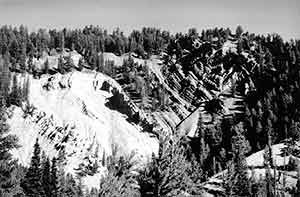|
Page
17
|
Central
Idaho Black-Shale Mineral Belt
In the mountains around
Sun Valley the stratigraphic units are different, and generally darker-colored,
than in southeast Idaho thrust belt or in the area from the Lost River to the
east. Here, in the Pioneer, Boulder, and Smoky Mountains, are thick Lower Paleozoic
black shales, such as the Devonian Milligen formation, which occupies much of
the low country east and west of the Wood River Valley. The Milligen contains
mineralized black shales, from which rich silver-lead-zinc veins were mined
following an exploration boom in the 1880s.
 |
| Large anticline (left) with small amplitude folds on right skyline, upper Paleozoic limestones, east side Lost River Range north of Borah Peak, view looks northwest, (July, 1990). |
 |
| Keyser Creek anticline, above the Darby thrust, looking north in Little Grey's River, northwest Wyoming. Folded rocks are Jurassic Twin Creek Formation, (September, 1981). |
 |
| Bare hills west of the Wood River Valley, looking northwest from north of Bellevue, (December, 1987). Colorado Gulch is immediately south of the kinked ridge. The rich silver and lead strikes of the Wood River Valley in the 1880s were mainly in black shales in these hills. |
In the southern Pioneer Mountains are over 15,000 feet of Mississippian conglomerates and sandstones of the Copper Basin Formation, deposited in a deep-sea fan environment north and east of a highland that may have stood under the present Snake River Plain. Above the Milligen formation in the Wood River area are thick calcareous siltstones and sandstones of the Pennsylvanian and Permian Sun Valley Group (including the Wood River Formation), which were deposited in deep water west of a carbonate bank that existed in what is now the Lost River Range area.
Idaho Batholith Metamorphic
Core Complexes
After intrusion of the Idaho
batholith, there was a general relaxation of compression after Mesozoic crustal
thickening. The general process of uplifting and thinning of over-thickened
crust results in the juxtaposition of ductilely deformed high-grade metamorphic
lower crust against brittlely deformed low-grade metamorphic upper crust. This
process has produced the metamorphic core complexes which are present along
the length of the North American cordillera. In southern and central Idaho the
Pioneer Mountains and the Albion-Raft River Mountains are metamorphic core complexes.
Pioneer
Mountains
At the same time as the
Challis volcanic rocks were erupted, the Pioneer Mountains metamorphic core
complex was rising. Low-angle extensional and strike-slip faults formed in the
Boulder and Pioneer Mountains northeast of Ketchum. The general sequence of
events was 1) Cretaceous intrusion ending by 70 million years ago; 2) formation
of northwest-striking high angle faults as well as low-angle oblique-slip faults,
ending about 45(?) million years ago; this faulting stripped sedimentary cover
from the Pioneer Mountains; 3) volcanic activity of the Challis volcanic episode
and faulting of the northeast-striking Trans Challis fault system; intrusion
of the Summit Creek stock in the core of the Pioneer Mountains at about 48 million
years ago; 4) intrusion of late-stage granite plutons (Sawtooth, Boulder, Pioneer
and Smoky Mountains) and related rhyolite volcanism about 44 million years ago,
5) final uplift and unroofing of Pioneer Mountains core complex (37 to 34 million
years ago); the Summit Creek stock was beheaded by this faulting and its upper
portion moved northwestward by as much as 23 km.
The
Albion Range and The Silent City of Rocks
In the Albion Mountains, the oldest
rocks are gneisses of the Archean Green Creek Complex. These are overlain by
several Proterozoic and Paleozoic sedimentary formations which have been much
folded and faulted. The domal shape of the core complex is evident in the form
of Mount Harrison south of Albion, on which the Pomerelle ski area is built
(miller and others, 1983). The principle structural zone along which the core
complex was uplifted south of Oakley is the Middle Mountain Shear zone, which
occupies the valley of Birch Creek and much of Middle Mountain. This shear zone
ceased moving about 35 million years ago.